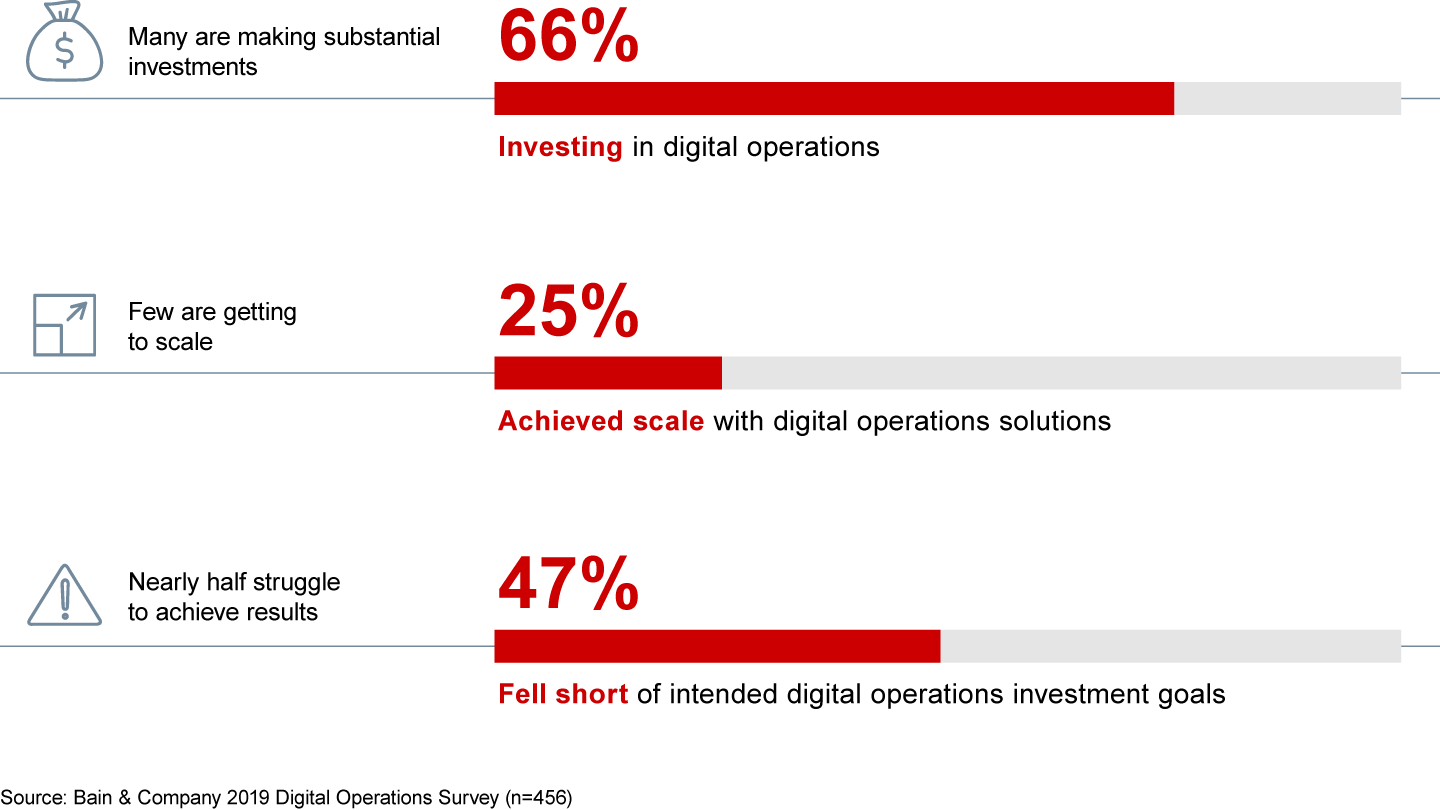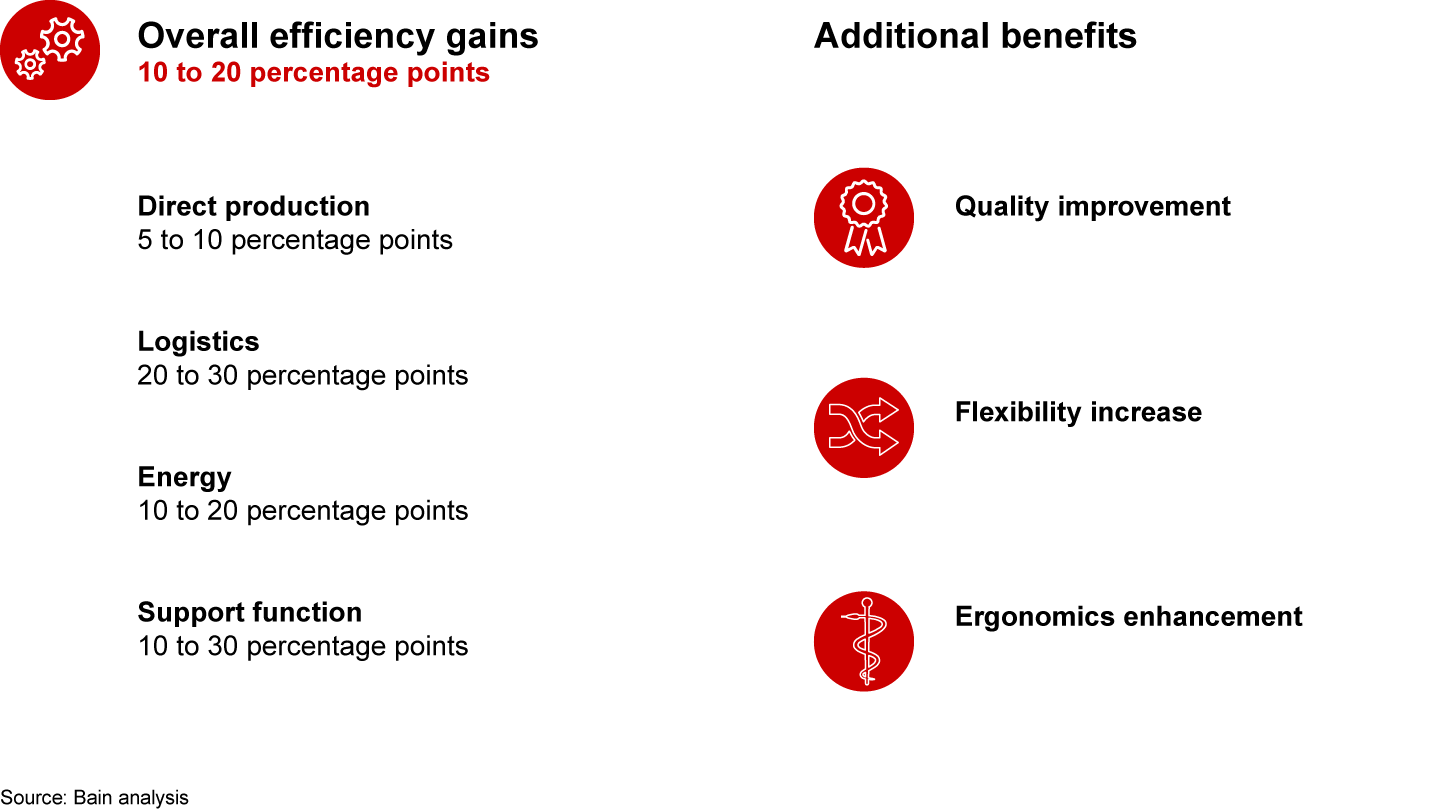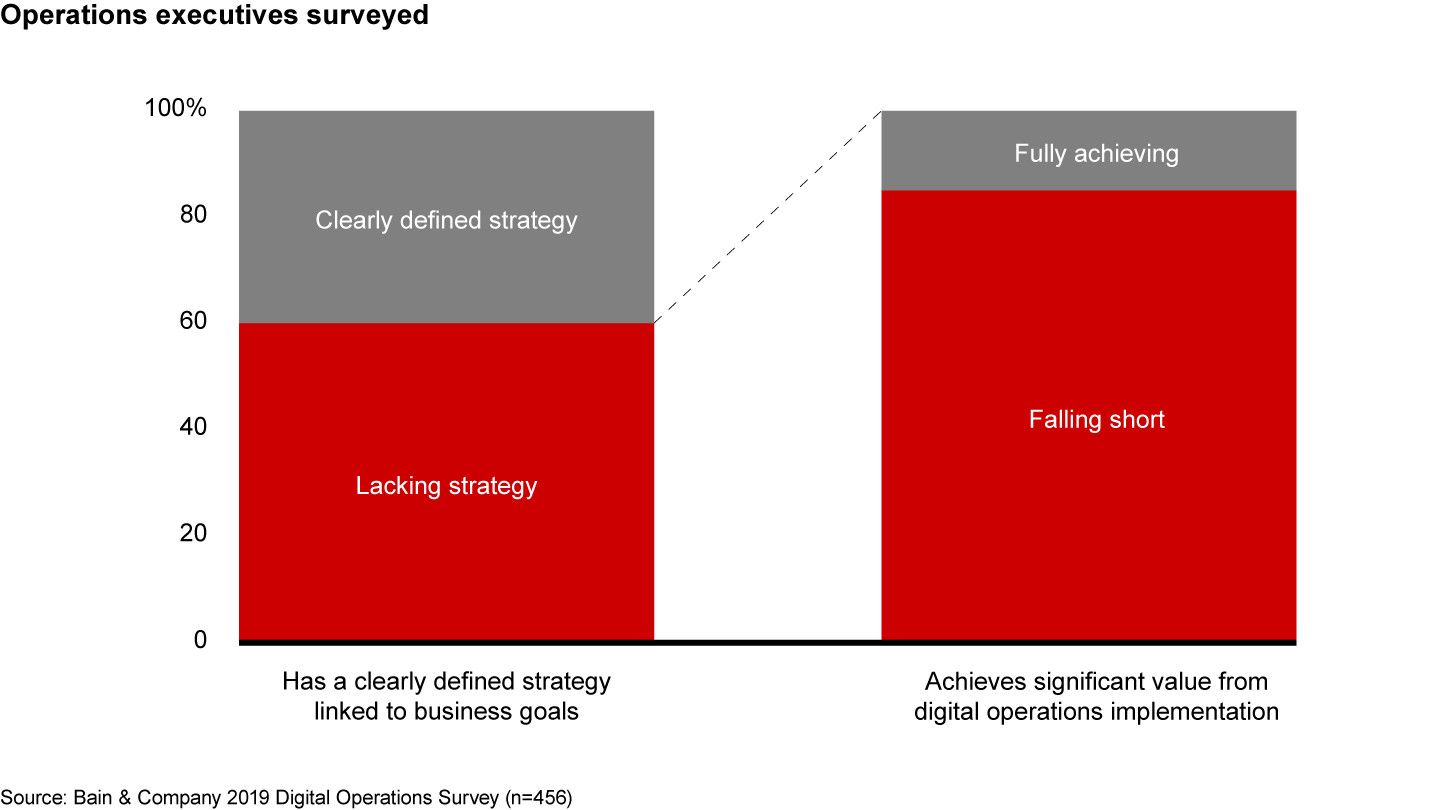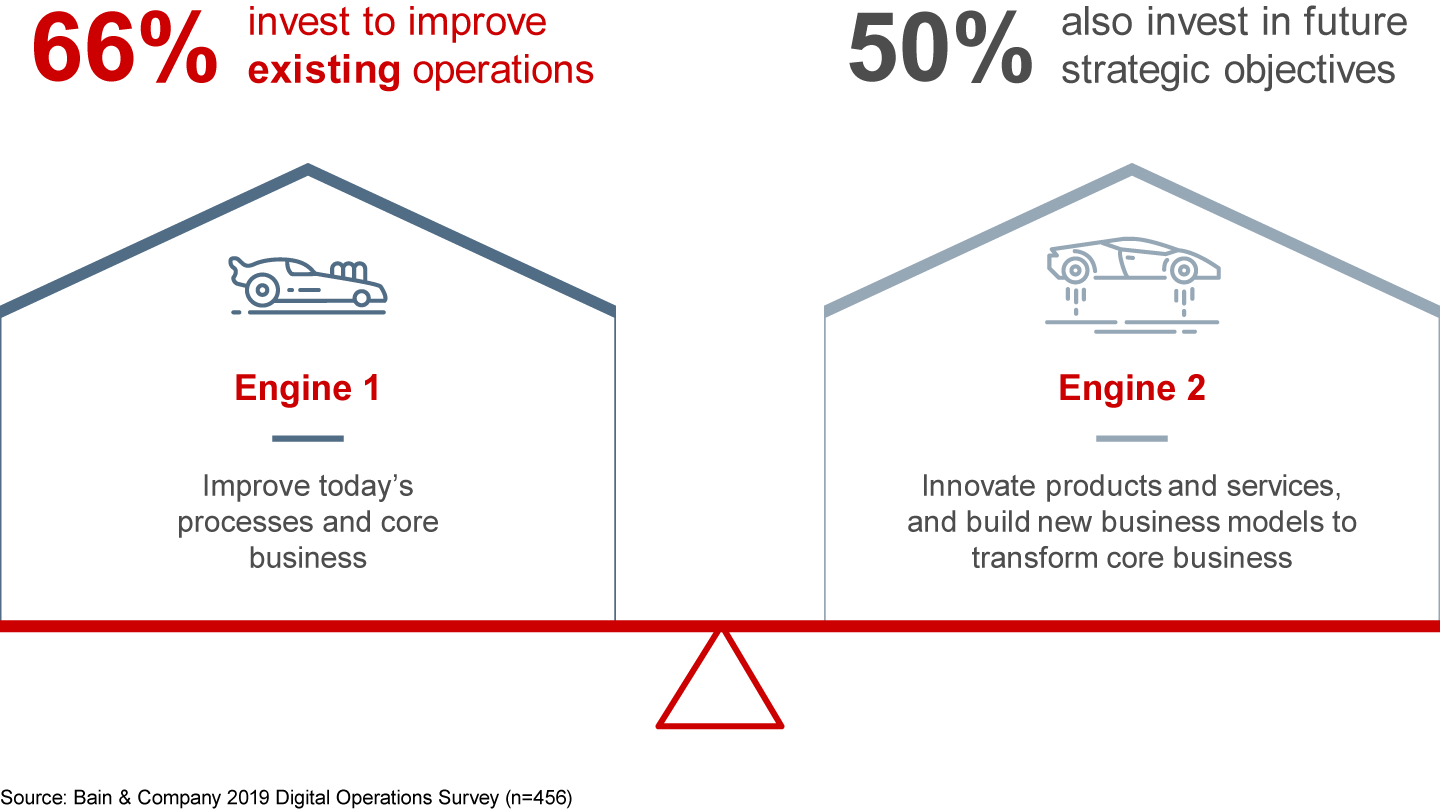Brief

한눈에 보기
- Digitalizing operations can improve total production efficiency by up to 20 percentage points.
- Leadership teams that link digital operations with the firm’s long-term strategy are three times more likely to achieve their goals.
- A digital operations transformation doesn’t require a greenfield plant—about 80% take place in existing factories.
With industry cost pressures mounting, a global automobile manufacturer decided to invest more than $500 million in a greenfield factory infused with digital technology. The goal is to make quantum leaps in operational efficiency, quality and flexibility. Big data, advanced analytics, collaborative robots and connected hardware will help deliver cost savings of up to 20% in production and up to 30% in support functions—a step-change improvement over the typical 2% to 3% annual targets. The next-generation plant will also serve as a benchmark for the company’s global production network.
It’s an audacious plan. Most companies are piloting digital tools in some parts of their organization, but few are moving ahead with a full-scale implementation. Bain research shows that 66% of US manufacturing executives are making significant investments to digitalize operations but that only 25% are rolling out solutions enterprise-wide—and nearly half of those we surveyed reported disappointing results (see Figure 1).

That’s a missed opportunity. Digital tools can accelerate speed to market, improve agility and lower costs. They also can alter a company’s strategic direction, helping to unleash innovation in operations and increase the business’s competitive edge. Leaders improve total production efficiency by 10 percentage points to 20 percentage points and reap significant savings in logistics, energy costs and human resources (see Figure 2). And those gains don’t require a state-of-the-art greenfield plant. About 80% of digital operations transformations occur in existing factories. Typically, companies maintain a normal production schedule while rolling out easy-to-use digital solutions that deliver significant benefits.

Despite the potential upside, most leadership teams worry that digitalizing large parts of a supply chain will be difficult, costly and time consuming. In our experience, the problem isn’t technology. Companies incur delays and increased costs for two key reasons: lack of focus and missing capabilities. Outdated management practices also get in the way of efficient implementation. Sixty percent of the executives we surveyed said that they lacked a clear strategy for digitalizing operations. Of those investing without a defined strategy, four out of five struggled to produce significant value. Companies that invest year after year in pilots or that start investing without a strategic plan don’t achieve substantial returns on their investments (see Figure 3).

By contrast, leadership teams that link digital operations with the firm’s long-term strategy are three times more likely to achieve their goals. Let’s take a closer look at the challenges of implementing digital investments enterprise-wide and how leaders are overcoming obstacles to achieve powerful results.
The digital future
It’s easy to feel overwhelmed by the deluge of digital technologies and solutions flooding the market. Which ones matter most? Executives say big data, analytics, robotics, automation and sensors will enable four critical innovations.
The first is smart automation: Robots and other automation systems will accelerate operational processes, improve flexibility and pave the way for increased customization of products. Japan’s Fast Retailing is investing in a two-armed robot that can pick up T-shirts and neatly pack them for shipping to customers—a key step toward automating the flagship warehouse of subsidiary Uniqlo. Automation also will reduce error rates and improve efficiency.
The second innovation is end-to-end visibility and collaboration across the entire supply chain, including third-party suppliers. A step change in supply chain visibility will increase efficiency and improve the ability to trace products from the source all the way through production and distribution.
Third, digital technologies will give rise to intelligent supply chains through advanced research and development management, planning strategies and forecasting. A retailer that feeds external data such as weather forecasts, macroeconomic trends and partner data into its inventory planning, for example, can react in real time to a cold snap, an economic slowdown or a shortage of supplier stock. The benefits include faster speed to market, tighter inventory, lower stock-out rates and improved sales.
Finally, digital tools will support next-generation employees, enhancing their productivity, boosting capabilities and increasing safety.
Powering Engine 2
In addition to improving existing processes, digital technologies are enabling new products and business models, blurring the lines between operations and strategy. Two-thirds of companies invest in digital operations to improve existing processes, such as automating a car production line, but 50% of executives we surveyed also are tapping digital tools for a range of strategic objectives, such as innovating on today’s products and services, building new business models and creating new revenue streams (see Figure 4).

That’s a huge advantage for companies grappling with disruption. Whether or not a disruptive threat is visible, successful leadership teams are starting to toggle between running their core business (today’s engine) as efficiently as possible and continuing to innovate there while also seeking to create new products and business models (tomorrow’s engine) based on changing customer needs, new competitors, new economics or all three.
Netflix deployed this Engine 1, Engine 2 approach during the mid-2000s. While running its core DVD business, the company launched a new delivery model based on content streaming. Netflix’s Engine 2 strategy ultimately disrupted the DVD rental industry, but along the way, it meant competing on two fronts until the streaming business took off. At the time, investing in digital technology to automate DVD warehouses was an option for improving efficiency, but it would have been a poor investment given the strategic shift to streaming content.
Getting started
Companies that reap the biggest benefits from investments in digital operations take a strategic approach from the outset. They link investments to strategy, prioritize investments that create the most value, adapt their organizational model and move uncomfortably fast.
Connect operations and strategy. Leadership teams tend to focus on an overly narrow set of goals when digitalizing operations. Our survey showed that 80% of executives are mainly seeking cost savings. Many overlook the opportunity to improve the reliability and flexibility of their supply chains and to pursue strategic opportunities. Leaders don’t ignore cost benefits, but they focus primarily on improving quality, speed, reliability and visibility across the entire supply chain.
Take the case of a major US retailer that was struggling with rising consumer expectations in e-commerce. The management team realized that it quickly needed to increase its speed and flexibility within inventory management, distribution and delivery. The most effective solution was to digitalize operations. The company collaborated with an autonomous robotics company to reduce required warehouse space and labor, developed a strategy to minimize store inventory and enable rapid replenishment, and acquired a same-day delivery company. The results were dramatic: a 49% year-over-year increase in digital sales, a 25% to 40% reduction in warehouse size and an 80% reduction in distribution center labor costs.
Invest in the big value creators. A highly fragmented technology and vendor landscape offers companies endless opportunities to test, learn and spend. The risk is ongoing experimentation with minimal benefits. Often digital experiments originate as grassroots initiatives led by enterprising department heads who are keen to improve specific processes. Their decisions make sense in isolation, but the resulting hodgepodge of initiatives scatter investment dollars and management focus, undercutting the ability to focus on key business outcomes.
Successful companies learn to say no to further experimentation. They prioritize technologies that will create the greatest value based on their industry and strategy. That requires alignment on the strategic priorities and a disciplined approach to piloting and scaling new solutions.
The previously mentioned global automobile manufacturer took a strategic approach in designing a digital plant. The leadership team identified potential digital solutions and ranked them by the value that they would generate and the feasibility of rolling them out at scale. The company’s resulting greenfield factory incorporated the highest-value technologies, delivering efficiency gains that were 10 times greater than the industry average.
Build a smart digital organization. Companies that fail to move beyond digital pilots end up with isolated pockets of innovation and limited benefits. Sometimes the challenge is the technology itself, since many companies need to integrate new systems with legacy infrastructure. Bridge technologies can address that challenge. Leading equipment makers are retrofitting production lines with sensors to capture data for analytics, and they are incorporating smart connectivity to enable remote support services.
Most often, however, the key difference between leaders and laggards is the capability to roll out digital technology at scale. Leaders ensure that they have the right people in the right roles, sufficient digital talent, strong governance structures and an executive team aligned with the digital operations strategy. Just as critical, they embrace new capabilities, such as Agile ways of working, and collaborate with start-ups to make the most of cutting-edge technologies.
Successful companies set up robust orchestration and scaling programs with dedicated teams to oversee the transformation. For example, one global industrial company used a central team with three main charters to roll out a digital operations program across multiple sites. It developed the overall digital roadmap and worked with initiative teams across sites to ensure successful implementation. It also built critical capabilities in Agile management and analytics, embedding expertise within initiative teams across all sites. Finally, the central team set the pace of change. The program has delivered $50 million in run-rate value across two sites in less than a year (from a total of roughly $450 million identified value at run rate).
Move uncomfortably fast. Most companies are still operating at yesterday’s pace in vetting new technologies. As disruption accelerates, executive teams need to move faster in deciding which pilots to scale. They also need to set clear criteria to kill unproductive investments quickly and redirect resources.
Our research shows that 80% of the leaders in digital operations have developed next-generation organization capabilities to accelerate change, including Agile management, supplier-customer collaboration and external partnerships. Success stories can help roll out promising technologies throughout the organization. Leaders also make sure that support functions such as procurement and IT are in step with faster cycle times.
The required pace can feel uncomfortable to executive teams accustomed to multiyear plans, detailed business cases and thorough due diligence, but the new approach builds flexibility into the strategic process. For example, instead of charting a full digital transformation, companies can define their digital destination and then take a stepping-stone approach. What matters most in this new landscape is the ability to pivot and change course quickly when needed. That’s because as companies start down the digital path, the wisest second step may not be clear until they have taken the first step.
Investing in digital operations is a journey with tremendous potential. As the lines between strategy and operations blur, getting this transformation right can create a huge competitive advantage. Already, the gap between leaders and laggards is growing. Our experience shows that a handful of success factors can make all the difference. Digital innovation will make companies of the future exponentially smarter and faster. Those that put it to work will forge a new era in operations.
Stephan Zech and Jörg Gnamm are partners with Bain & Company’s Performance Improvement practice. Emilia Fallas is the global practice director for the firm’s Performance Improvement practice. Stephan and Emilia are based in Bain’s Los Angeles office. Jörg is located in the Munich office.



